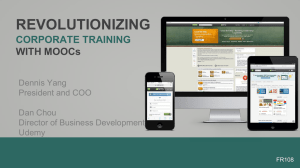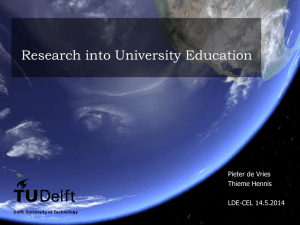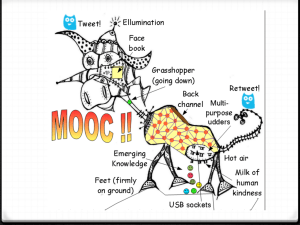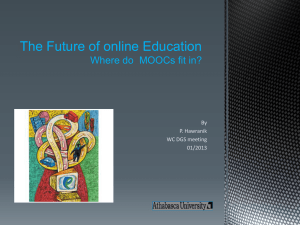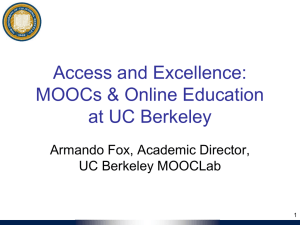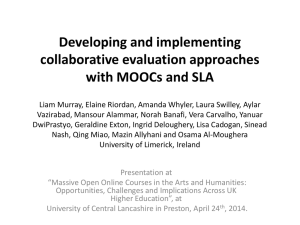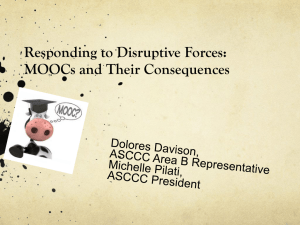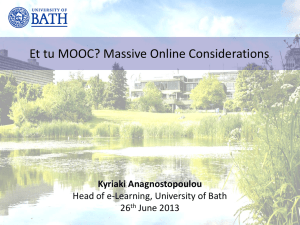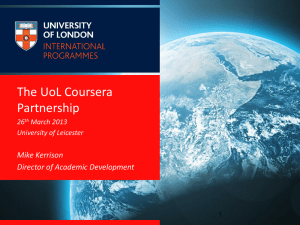pptx - Common Solutions Group
advertisement
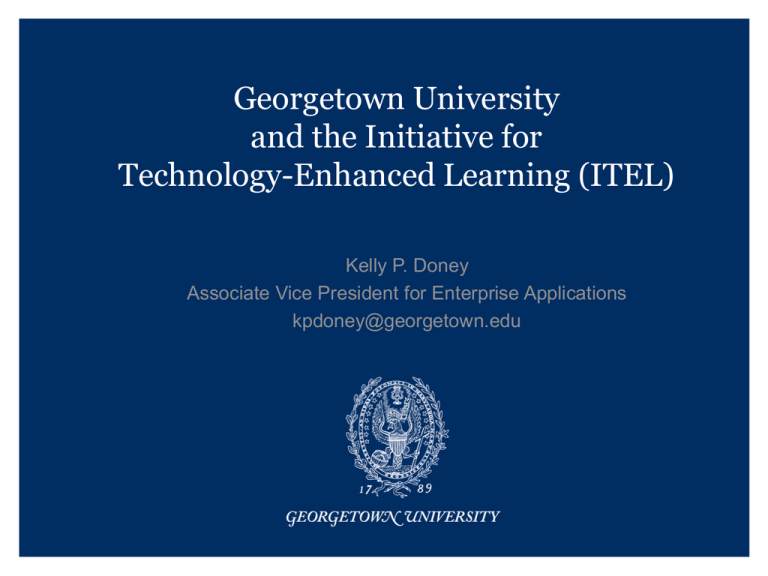
Georgetown University and the Initiative for Technology-Enhanced Learning (ITEL) Kelly P. Doney Associate Vice President for Enterprise Applications kpdoney@georgetown.edu Agenda • Initiative on Technology-Enhanced Learning (ITEL) • Selecting a MOOC Partner • Process to select faculty to develop and deliver MOOCs • Online Learning Architecture • Q&A 2 Initiative on Technology-Enhanced Learning Online Courses MOOCS Classroom of the Future Blended Learning Courses • Initiative to strengthen teaching and learning in on-campus programs and enhance Georgetown’s online activity globally. • Experiment with new approaches to interactive learning. • 100 faculty involved from 43 departments and programs. • Impact on 2000+ GU students in the first year in the 23 ITEL oncampus project target courses. • Will impact thousands of students worldwide through MOOCs 3 MOOC Platform Selection Process Identified Desired Platform Criteria Analyzed Platform Options Developed Funding Strategy Faculty Grants Instructional Design Selected a Partner edX 4 Technology MOOC Partner Decision Matrix Characteristic Pedagogical Excellence Classroom of the Strong focus Future Online Mission Alignment MOOCS Yes Courses (Core Jesuit Values) EdX Blended Learning Courses Selective Market Placement Small group of elite partners 5 Platform Open source, allows for GU contributions Blending with on-Campus offerings Yes Research, Data, and Analytics Emphasized Advantageous Equity Partnership GU is a partner Process to Select Faculty to Develop MOOCs Faculty Submit 55 Initial Conceptual Proposals in February 2013 Review Committee Selects Projects for Full Proposal Development Faculty Submit Full Proposals to Compete for Grants in March 2013 43 Proposals are Peer-Reviewed and Ranked by 8 teams of Faculty in April 2013 ITEL Grant Selection Committee Awards 28 ITEL Grants on May 1 2013 5 grants for MOOCs 6 ITEL Status Program Next Steps ITEL Faculty Working Group (Faculty led with the Transforming our Online Learning Architecture. Provost) Fundraising to support ITEL Programs and Selected 2 MOOCs for Fall 2013 Launch: infrastructure improvements. oBioethics Adding MOOC Courses for Spring 2014 and beyond. oGlobalization: Winners and Losers Deploying 9+ online MS and online Certificate Technology Programs. Developing our Online Learning Strategy Developing classroom of the future. Planning for new distance education programs. Working with Blackboard and Deltak to transform our Online Learning Systems platforms to accommodate online programs. Continuing to move forward on ITEL initiatives Supplementing wi-fi infrastructure. Adding online learning system technologists. Participating in the edX Consortium Technology Sub-Committee. 7 Foundation Online Learning Architecture Key Components of Online Learning Architecture 8 Library Resources Synchronous Collaboration Rich Media Lecture Capture Social Tools: academic resources, databases, Digital Commons, CNDLS Tools Google Apps, Facebook, YouTube, Instagram, Twitter, Google+, and other social platforms Teaching and Learning Management System University Identity Management Credit SIS University Authentication Non-credit SIS Business Continuity/Disaster Recovery Current Online Learning Systems Architecture University Authentication (LDAP/Shibbolet h) The Big Cloud (Various) Lecture Capture (Echo360) Synchronous Collaboration (Blackboard Collaborate) Synchronous Collaboration (Adobe) Law Center Library Systems (III Millennium) Course Management System (Embanet Compass) Course Management System (Law: Classroom 24/7) Course Management System (Law: Homegrown) Course Management System (2U) Course Management System (edX) Teaching and Learning Management System (Blackboard) (III Millennium) Course Management System (Deltak) Rich Media Non Credit Student System Credit Student System (Banner) (Share Stream) Course Management System (Law: TWEN) (Destiny One) Business Continuity/D isaster Recovery (Amazon or other cloud) 9 Main Campus & School of Medicine Library Systems Business Continuity/Di saster Recovery Environment (Virginia Data Center) University Identity Management (NetID) Rich Media (Kaltura) Online Learning Systems Architecture: A Future We Can Support The Big Cloud Lecture Capture (Echo360) (with Distance Ed provider Services) University Authenticatio n (LDAP/Shibbol eth) Synchronous Collaboratio n (Blackboard Collaborate) Synchronous Collaboratio n (Adobe) Course Management System (edX) Course Management System (2U) Library Systems (III Millennium) Teaching and Learning Management System (Blackboard) Rich Media (Share Stream) Non Credit Student System (Destiny One) Credit Student System (Banner) Business Continuity/ Disaster Recovery (Amazon) 10 Business Continuity/Di saster Recovery Environment (Virginia Data Center) University Identity Management (NetID) Rich Media (Kaltura) Our Lessons Learned • Architecture – Develop architectural strategy driven by smart IT • Force vendors to create features/functionality that meet user requirements and expectations • Protect data and IP – Minimize point solutions – Require vendor integration with your architecture – build it into the contract • ITEL, MOOCs, and Distance Learning - Leadership from the President and the Provost were essential as was faculty involvement - Transparent processes and involvement of key non-faculty stakeholders (UIS, Center for New Designs in Learning and Scholarship, Libraries, Deans) made decision-making happen quickly 11 Q&A itel.georgetown.edu uis.georgetown.edu kpdoney@georgetown.edu Facebook: Georgetown UIS
